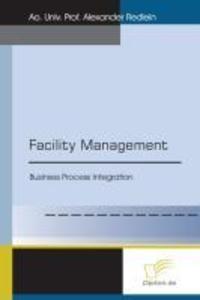
Sofort lieferbar (Download)
Integration of processes and supporting IT tools is a key factor for successful Facility Management.
After a review of the present situation of Facility Management the author describes an "integrated" process model for the conception, planning and construction processes of facilities, providing integration into the whole life cycle. The target costing method is presented as a means to grant proper conception, planning and construction in accordance with the needs of the investor, the user and the operator. To be able to provide figures for the target costing methodology, a concept for efficient IT process support during the utilisation phase is developed. This includes two levels: the operative level and the controlling level based on the data of the operative processes. The concept is based on standard reference models of the key FM processes of the utilisation phase and on an analysis of the existing functionality of the relevant IT tools.
A concept for the integration of existing IT tools is presented, that provides the necessary interaction and data exchange to support the newly introduced parts of the workflow. Based on this integration unified objects are defined, combining the distributed information of the FM business objects. This results in a joint FM database structure. The support of the operative processes and the joint data structure enable standardised calculation of benchmarks for controlling purposes. Finally, these benchmarks are the basis for a statistical method that allows the calculation of the utilisation costs in the conception phase.
After a review of the present situation of Facility Management the author describes an "integrated" process model for the conception, planning and construction processes of facilities, providing integration into the whole life cycle. The target costing method is presented as a means to grant proper conception, planning and construction in accordance with the needs of the investor, the user and the operator. To be able to provide figures for the target costing methodology, a concept for efficient IT process support during the utilisation phase is developed. This includes two levels: the operative level and the controlling level based on the data of the operative processes. The concept is based on standard reference models of the key FM processes of the utilisation phase and on an analysis of the existing functionality of the relevant IT tools.
A concept for the integration of existing IT tools is presented, that provides the necessary interaction and data exchange to support the newly introduced parts of the workflow. Based on this integration unified objects are defined, combining the distributed information of the FM business objects. This results in a joint FM database structure. The support of the operative processes and the joint data structure enable standardised calculation of benchmarks for controlling purposes. Finally, these benchmarks are the basis for a statistical method that allows the calculation of the utilisation costs in the conception phase.
Inhaltsverzeichnis
1;Facility Management;1 2;Table of Contents;3 3;Table of Figures;7 4;Abbreviations;9 5;1. Introduction;11 6;2. Definition of FM;15 6.1;2.1. Method;23 6.2;2.2. Procedure;25 6.3;2.3. Project Function Tree;26 7;3. Conception, Planning and Construction Phases;31 7.1;3.1. Life Cycle of Real Estate Property;31 7.1.1;3.1.1. Project Development Phase;31 7.1.2;3.1.2. Utilisation Phase;32 7.1.3;3.1.3. Vacancy Phase;33 7.1.4;3.1.4. Redevelopment and Demolition Phase;34 7.2;3.2. Integration of the Phases of the Life Cycle;35 7.3;3.3. Role-players in Real Estate Property Management;39 7.3.1;3.3.1. Proprietor;39 7.3.2;3.3.2. Operator of Real Estate;44 7.3.3;3.3.3. User;46 7.4;3.4. The Roles of the Architect and the Engineering Consultants;47 7.5;3.5. The Role of the Project Manager;52 7.6;3.6. Programming;63 7.7;3.7. Target Costing;66 7.8;3.8. Organisation;71 7.9;3.9. Data Structures;74 7.9.1;3.9.1. Data Filing and Archiving;75 7.9.2;3.9.2. Workflow / Document Routing;76 7.9.3;3.9.3. Content / Structure of Documents;76 8;4. Utilisation Phase;79 8.1;4.1. Introduction of FM;79 8.2;4.2. Process Types;80 8.3;4.3. Practical Example Accounting;82 8.3.1;4.3.1. Order, Invoice, Booking;82 8.3.2;4.3.2. Charging FM Costs;83 8.4;4.4. IT Landscape;87 8.4.1;4.4.1. Computer Aided Facility Management Systems;87 8.4.2;4.4.2. Enterprise Resource Planning Systems;90 8.4.3;4.4.3. Building Automation (BA) Systems;93 8.4.4;4.4.4. Geographical Information Systems;93 8.4.5;4.4.5. Other Special Purpose Tools;94 8.4.6;4.4.6. Tools to provide Basic Data;94 8.4.7;4.4.7. Process Support and Gap Analysis;95 8.5;4.5. Concept for Improvement;96 8.5.1;4.5.1. Problems of the Conventional Process Support;98 8.5.2;4.5.2. Goals of the Software Solution;99 8.5.3;4.5.3. Collaborative Development;101 8.5.4;4.5.4. Process Analysis;102 8.5.5;4.5.5. Basic Integration Methods;102 8.5.6;4.5.6. New Concept of Integration - Daemon;110 8.5.7;4.5.7. Example Implementation;114 8.6;4.6. Processes and Data Structures;117 8.6.1;4.6
.1. Cost Accounting;117 8.6.2;4.6.2. Human Resources;119 8.6.3;4.6.3. Asset Management;122 8.6.4;4.6.4. (Corporate) Real Estate Management;126 8.6.5;4.6.5. Maintenance;132 8.6.6;4.6.6. Building Automation;136 8.7;4.7. Conclusion;146 9;5. Benchmarking;148 9.1;5.1. General Problem;148 9.2;5.2. Data Structure and Standardisation;150 9.2.1;5.2.1. Property and Building Related Data;150 9.2.2;5.2.2. Cost Related Data;152 9.2.3;5.2.3. Quality Related Data;155 9.2.4;5.2.4. Other Data;156 9.3;5.3. Management Information Systems;156 9.3.1;5.3.1. Data Warehouse Concept;156 9.3.2;5.3.2. Business Data Warehouse Systems;159 9.4;5.4. Results of Benchmarking;161 10;6. Conclusion;163 11;7. Discussion;166 12;8. Reference;169 13;Appendix;180
.1. Cost Accounting;117 8.6.2;4.6.2. Human Resources;119 8.6.3;4.6.3. Asset Management;122 8.6.4;4.6.4. (Corporate) Real Estate Management;126 8.6.5;4.6.5. Maintenance;132 8.6.6;4.6.6. Building Automation;136 8.7;4.7. Conclusion;146 9;5. Benchmarking;148 9.1;5.1. General Problem;148 9.2;5.2. Data Structure and Standardisation;150 9.2.1;5.2.1. Property and Building Related Data;150 9.2.2;5.2.2. Cost Related Data;152 9.2.3;5.2.3. Quality Related Data;155 9.2.4;5.2.4. Other Data;156 9.3;5.3. Management Information Systems;156 9.3.1;5.3.1. Data Warehouse Concept;156 9.3.2;5.3.2. Business Data Warehouse Systems;159 9.4;5.4. Results of Benchmarking;161 10;6. Conclusion;163 11;7. Discussion;166 12;8. Reference;169 13;Appendix;180
Produktdetails
Erscheinungsdatum
01. August 2004
Sprache
englisch
Seitenanzahl
228
Dateigröße
1,48 MB
Autor/Autorin
Alexander Redlein
Verlag/Hersteller
Originalsprache
englisch
Kopierschutz
ohne Kopierschutz
Family Sharing
Ja
Produktart
EBOOK
Dateiformat
PDF
ISBN
9783842807075
Entdecken Sie mehr
Bewertungen
0 Bewertungen
Es wurden noch keine Bewertungen abgegeben. Schreiben Sie die erste Bewertung zu "Facility Management" und helfen Sie damit anderen bei der Kaufentscheidung.









